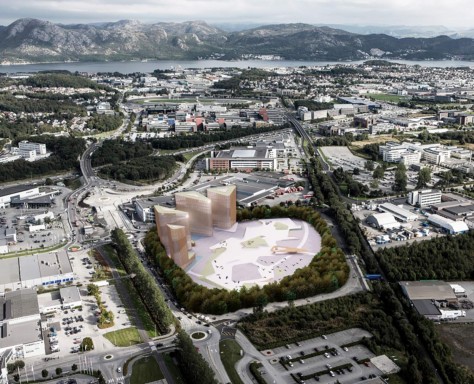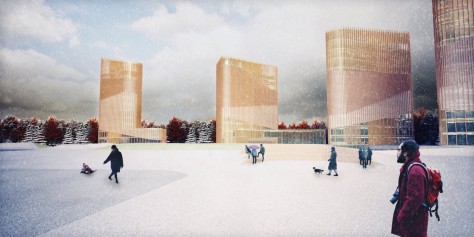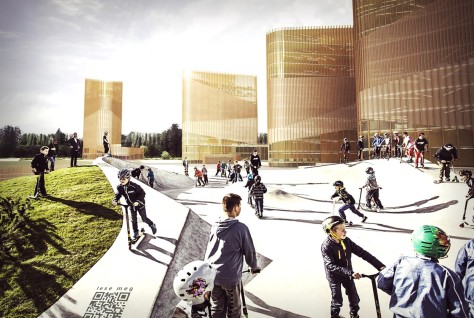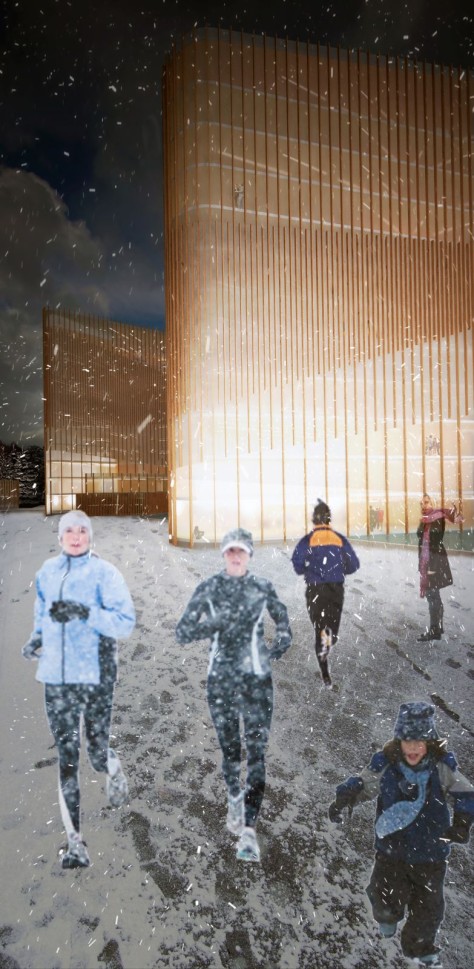
Problem definition
While people have increasingly turned their mobile devices into everyday fellow travelers and the accessed data or scripted information into new forms of outdoor companion, the interaction between their activities and open public spaces tend to become rather synergistic. The urban landscape is failing all on its own; green public spaces in Norway and around Scandinavia with their traditional landscape features seem unable to sustain the new emerging forms of presences.

The digital flâneur remains an uninvolved screen-driven perceptive visitor. A new urban square in Forus responds to this phenomenon by proposing a green-bounded wireless space for business, sports, leisure and -most of all- outdoor tablet-driven social activities. Wireless connectivity has transformed it into an (even more) complex system that is part spatial, part immaterial and interactive. In this project, we approach the Forus CyberPark as such a complex system to develop not only a method of future urban design principles but also a way of understanding how people use media and locative technologies in their attempt to appropriate and make sense out of space’s new intangible properties.

Methodological Response
How do we encourage people to come out of their offices or houses to perform the same data-driven activities (surfing, chatting, messaging etc.) but this time … outdoors? How do we create a low-cost urban development by using wireless capabilities to enhance its everyday function? The CyberPark of Forus is conceived as an interactive digital narrative where Information and Communication Technologies (ICT) cooperate with urban and architecture design to propose something unique. A technologically enhanced public space and the development of Norway’s first digitally responsive and intelligent urban place. Prior to formulating our design proposal, we were interested in exploring the ways different people experience the study area and its surroundings.

The analysis of the area’s urban morphology, through maps or other representations, was rather limited in revealing the actual ways in which a site is being used by its inhabitants or visitors. We conducted real-time social media monitoring in the wider area of Stavanger (May 2015), gathering dynamic and geo-referenced data from Twitter, Instagram, and Foursquare for a period of one month. By visualizing the collected information in various ways, we were capable of understanding the activity patterns of different types of people within the urban environment. The large-scale dataset we managed to acquire, albeit only representing social media users, gave us the opportunity to comprehend how different social groups experience the city and, in particular, the area of Forus.

Development
We propose a different spatial configuration with many syntactical advantages that develops gradually in three chronical phases: finally, a ring-like formation made out of nature (forest) protects the wireless dataflow of the inside territory while a sensitive core of four tall wooden buildings plays the role of the Nordic Landmark in the area. Being visible from distance, it helps users to navigate and orientate themselves in a rather homogenous environment. Inside the wireless public space, the user is always surrounded by the forest while a data-network offers possibilities for outdoor post-digital experiences. The outdoor cyber-mediated space provides technologically mediated modalities. Smart urban furniture with embedded media objects (from sounds and images to projections and lighting) are called to attract public attention and interest.

In specific spots, more practical urban uses and services like mobile charging, Wi-Fi hotspots and urban sensing opportunities for measuring, for example, air pollution and traffic congestion are also employed within benches, post-boxes or public lighting in an attempt to make people more engaged in an effective use of -the otherwise- empty open public space.Now, a place-based IT mediated community is emerging from the cross points of our mobile activities and the physio-virtual organization of Statoil’s nearby public spaces. In this sense, locomotional participation, agency and interactivity between the user and the digitally displayed or wirelessly transmitted material seem to appear as elements of an evolved mode of cyberspatial outdoor experience. Source by aaiko arkitekter.

Location: Forus, Rogaland, Norway
Architects: aaiko arkitekter
Project Team: K. Ioannidis, I.A. Kolia + D. Gkikas
Collaborator: A. Psyllidis
Site authority: municipality of Stavanger, Norway
Year: 2015
Category: competition / architectural study
Images: Courtesy of aaiko arkitekter

